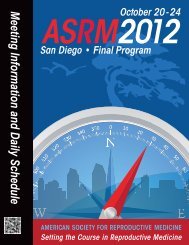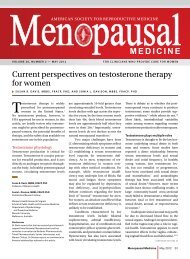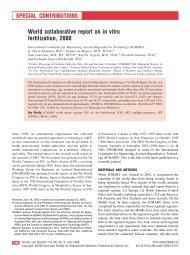scientific program • symposia - American Society for Reproductive ...
scientific program • symposia - American Society for Reproductive ...
scientific program • symposia - American Society for Reproductive ...
Create successful ePaper yourself
Turn your PDF publications into a flip-book with our unique Google optimized e-Paper software.
SCIENTIFIC PROGRAM <strong>•</strong> PLENARY SESSIONS<br />
Tuesday, October 18, 2011 11:15 am – 12:00 pm<br />
Contraception Day Keynote/Workshop<br />
LET’S GET SERIOUS: EVIDENCE CLEARLY SUGGESTS WHAT<br />
COULD BE DONE TO DIMINISH UNINTENDED PREGNANCIES<br />
Robert A. Hatcher, M.D., M.P.H.<br />
Emory School of Medicine<br />
Needs Assessment and Description<br />
The percentage of pregnancies that are unintended<br />
remains high in the United States at approximately 50%.<br />
One approach to decreasing the number of unintended<br />
pregnancies is to promote the use of long-term<br />
contraceptive methods such as the intrauterine device<br />
(IUD). Studies have shown that IUD acceptance increases if<br />
presented and inserted at the time of delivery. The goal of<br />
this symposium is to educate physicians and allied health<br />
professionals in the clinical utility and placement of IUDs.<br />
Learning Objectives<br />
At the conclusion of this session, participants should be able<br />
to:<br />
1. Educate their patients about the many advantages and<br />
few disadvantages of long-acting reversible<br />
contraceptives.<br />
Tuesday, October 18, 2011 2:45 pm – 3:30 pm<br />
Plenary Session 4<br />
THE SOCIETY OF REPRODUCTIVE SURGEONS LECTURE<br />
THE ROLE OF REPRODUCTIVE SURGERY IN THE ART ERA<br />
Endowed by a 1999 grant from Ethicon Endo-Surgery, Inc.<br />
Togas Tulandi, M.D.<br />
McGill University<br />
Introducer: Gary Frishman, M.D.<br />
Needs Assessment and Description<br />
Due to the availability of assisted reproductive technologies<br />
(ART), the need <strong>for</strong> reproductive surgery as a primary<br />
treatment <strong>for</strong> infertility has declined. However, it has<br />
an important role in improving the success rate of ART<br />
treatment and, recently, in fertility preservation. Reports of<br />
new indications and techniques are published continuously.<br />
Some warrant practice pattern changes and the need to<br />
educate practitioners not only to promote fertility, but also<br />
to preserve fertility and reproductive function of young<br />
women undergoing chemotherapy or radiation treatment.<br />
Learning Objectives<br />
At the conclusion of this session, participants should be able<br />
to:<br />
1. Summarize need and evidence-based development<br />
of minimally-invasive reproductive surgery to increase the<br />
success of assisted reproductive technologies.<br />
2. Describe surgical techniques to improve success rates<br />
after ART treatment.<br />
3. Outline various methods of fertility preservation, including<br />
ovarian transposition and ovarian cryopreservation and<br />
transplantation.<br />
Room 230 A/B<br />
Chapin Theatre<br />
Moderator: Richard S. Legro, M.D.<br />
60<br />
2. Explain why the copper T380A IUD is the emergency<br />
contraceptive of choice.<br />
3. Develop protocols <strong>for</strong> the placement of IUDs within 10<br />
minutes after delivery.<br />
ACGME COMPETENCY<br />
Patient Care<br />
TEST QUESTION:<br />
Which one of the following contraceptive methods is<br />
effective <strong>for</strong> 10-12 years, maybe longer, from when it is<br />
placed?<br />
A. Etonogestrel implant<br />
B. Etonogestrel vaginal ring<br />
C. Levonorgestrel implant<br />
D. Levonorgestrel intrauterine device<br />
E. Copper T 380-A intrauterine device<br />
ACGME COMPETENCY<br />
Medical Knowledge<br />
Patient Care<br />
TEST QUESTION:<br />
After participating in this session, I will do the following in my<br />
practice:<br />
A. Per<strong>for</strong>m diagnostic laparoscopy as the first step in an<br />
infertility evaluation.<br />
B. Prescribe antibiotics to women with hydrosalpinx be<strong>for</strong>e<br />
IVF treatment.<br />
C. Surgically repair a hydrosalpinx be<strong>for</strong>e IVF treatment.<br />
D. Remove all ovarian endometriomas be<strong>for</strong>e IVF<br />
treatment.<br />
E. Provide counseling <strong>for</strong> fertility preservation to young<br />
women undergoing local pelvic radiation or<br />
chemotherapy.<br />
F. Not applicable to my area of practice.








